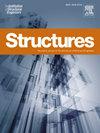基于计算机视觉的局部损伤识别下部结构隔离方法
IF 3.9
2区 工程技术
Q1 ENGINEERING, CIVIL
引用次数: 0
摘要
近年来,基于视觉的结构损伤识别技术因其简便性和成本效益而备受关注。然而,基于动态响应的视觉方法面临着与视场(FOV)限制有关的挑战,即为了确保足够的监测精度,视场的范围往往被牺牲掉,这就减少了结构健康监测(SHM)可用的数据量。本研究通过采用下部结构隔离法(SIM)提出了解决这一问题的方法,该方法侧重于结构的局部振动,通过隔离感兴趣的区域实现局部损伤识别。此外,还采用了核化相关滤波器(KCF)与子像素模板匹配相结合的方法来提取视觉传感器记录的振动信息。这种策略兼顾了位移提取的效率和准确性。在数值模拟中,比较了基于加速度响应和位移响应的 SIM 性能,证明了视觉传感器与 SIM 的潜在兼容性。最后,通过对剪切框架模型进行振动测试,验证了所提出的基于视觉的局部损伤识别方法的有效性。本文章由计算机程序翻译,如有差异,请以英文原文为准。
Computer vision-based substructure isolation method for localized damage identification
In recent years, vision-based structural damage identification techniques have garnered significant attention due to their simplicity and cost-effectiveness. Nevertheless, dynamic response-based vision methods face challenges related to the limitations of the field of view (FOV), i.e., the extent of the FOV is often sacrificed in order to ensure sufficient monitoring accuracy, which reduces the amount of data available for structural health monitoring (SHM). This study presents a solution to this problem by employing the substructure isolation method (SIM), which focuses on local vibrations of the structure and enables local damage identification by isolating the area of interest. Additionally, a method combining kernelized correlation filter (KCF) with sub-pixel template matching is used to extract vibration information recorded by visual sensor. This strategy balances both the efficiency and accuracy of displacement extraction. In numerical simulations, the performance of the SIM based on acceleration response and displacement response is compared, demonstrating the potential compatibility of visual sensors with the SIM. Finally, the effectiveness of the proposed vision-based local damage identification method is validated through vibration testing of a shear frame model.
求助全文
通过发布文献求助,成功后即可免费获取论文全文。
去求助
来源期刊

Structures
Engineering-Architecture
CiteScore
5.70
自引率
17.10%
发文量
1187
期刊介绍:
Structures aims to publish internationally-leading research across the full breadth of structural engineering. Papers for Structures are particularly welcome in which high-quality research will benefit from wide readership of academics and practitioners such that not only high citation rates but also tangible industrial-related pathways to impact are achieved.
 求助内容:
求助内容: 应助结果提醒方式:
应助结果提醒方式:


